
Understanding Drought: A Key to Water Security
Droughts are one of the most pressing issues facing the world today. With climate change wreaking havoc on global weather patterns, predicting and preparing for droughts has become a top priority for climate researchers and policymakers alike. However, a recent study by IIT Palakkad has revealed the complexity of drought prediction, showing that different indices yield varied outcomes. This raises important questions about the accuracy of our current methods and the need for more nuanced approaches to predicting and mitigating the impacts of droughts.
Why are droughts so hard to predict?
Droughts are notoriously difficult to predict, and the IIT Palakkad study highlights several reasons why. One major challenge is the fact that droughts are a complex and multi-faceted phenomenon, influenced by a wide range of factors including temperature, precipitation, soil moisture, and atmospheric circulation patterns. This makes it difficult to develop a single, universally applicable index for predicting droughts.
Another challenge is the fact that droughts can occur at different scales, from local to global, and can have different characteristics depending on the region and the time of year. For example, a drought in the Amazon rainforest may be characterized by a lack of rainfall, while a drought in the American Southwest may be characterized by a failure of precipitation to meet seasonal norms.
What do different drought indices reveal?
The IIT Palakkad study analyzed several different drought indices, including the Palmer Drought Index (PDI), the Standardized Precipitation Index (SPI), and the Soil Moisture Anomaly (SMA). Each of these indices provides a unique perspective on drought conditions, and the study found that they can yield very different outcomes.
For example, the PDI is a widely used index that takes into account both precipitation and temperature. According to the PDI, the 21st century is likely to be a dry one, with many regions experiencing more frequent and severe droughts. In contrast, the SPI, which is based solely on precipitation, suggests that the 21st century will be wetter than the 20th century.
The SMA, which focuses on soil moisture, paints a more nuanced picture, with some regions experiencing increased drought risk and others experiencing increased risk of flooding. This highlights the importance of considering multiple indicators when predicting and preparing for droughts.
Implications for water security
The findings of the IIT Palakkad study have significant implications for water security. By recognizing the complexity and variability of droughts, policymakers and researchers can develop more effective strategies for predicting and mitigating their impacts.
One key implication is the need for more localized and region-specific approaches to drought management. Rather than relying on a single, universal index, decision-makers can use a suite of indices to develop a more comprehensive understanding of drought conditions in their region.
Another implication is the need for more proactive and adaptive management strategies. By anticipating and preparing for the possibility of droughts, communities can reduce the risk of water scarcity and related social and economic impacts.
Conclusion
Understanding drought is a critical component of ensuring water security in the face of a shifting climate landscape. The IIT Palakkad study highlights the complexity and variability of droughts, and the need for more nuanced and region-specific approaches to predicting and preparing for their impacts.
By leveraging the insights of this study, climate researchers and policymakers can develop more effective strategies for managing droughts and ensuring a sustainable water future. Whether through the development of new indices, more proactive management strategies, or increased international cooperation, the key to water security lies in our ability to understand and adapt to the complex and ever-changing nature of droughts.
Source:
https://researchmatters.in/news/why-are-droughts-so-hard-predict-iit-pallakkad-study-explores-why






